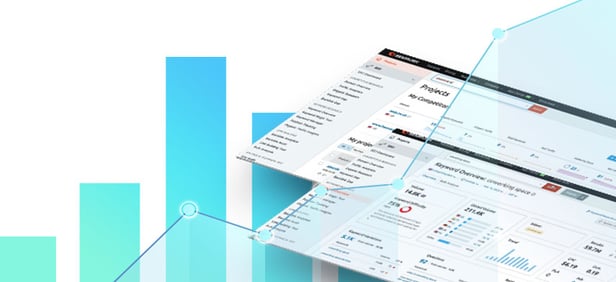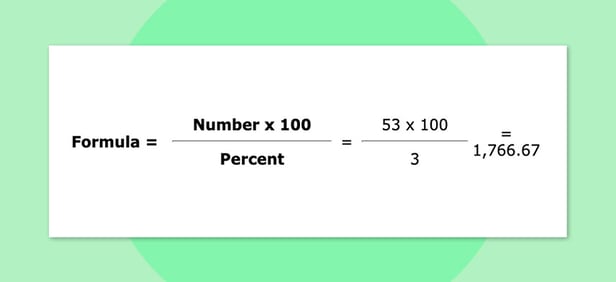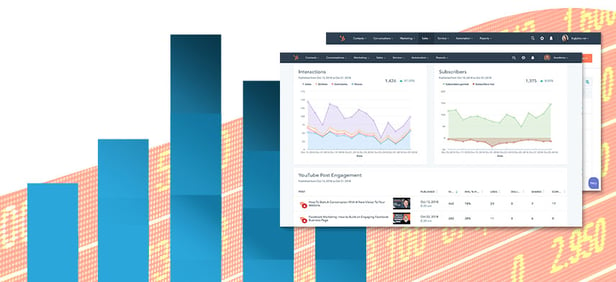We’ve always used our blog to grapple with the questions that challenge B2B marketers, but we’re renewing our focus on strategic issues – and honing in on some of the 'unsolvable' problems that keep CMOs up at night.
Why? Well, truth be told, we think that guidance on some fundamental issues is still sorely lacking. The subject of budget allocation is a perfect example. Here, all the usual suspects have published extensive (2000 word+) guides, but the advice they offer is woolly or vague at best.
Forbes propose three wildly-different methodologies for ascertaining your marketing budget, none of which come close to getting it right. Gartner are still obsessed with the relationship between company revenue and marketing budgets, which seems reductive at best. And HubSpot default to a dizzying array of generalisations that don’t really give you anything concrete to work with.
The thing is, CMOs are under real pressure to nail their budgeting. You don’t have time to pore over contradictory advice or work at deciphering esoteric formulas based on numbers that are ultimately unrelated to the question of marketing spend.
 That’s why we’re going to use this article to lay out a simple methodology that will help you work out exactly what you need to spend on digital marketing – and where you need to spend it. Note that we said simple, not easy:
That’s why we’re going to use this article to lay out a simple methodology that will help you work out exactly what you need to spend on digital marketing – and where you need to spend it. Note that we said simple, not easy:
This will only work if you dedicate some serious brainpower to figuring out what you really want from your marketing strategy – and where you’re going to get it.
But it's a fluff-free approach that will enable you to deliver results without worrying about whether you’re flushing your company’s hard-earned money down the toilet, and we think that makes it a very worthwhile exercise.
First, Start At The End
It sounds counterintuitive, but the only way to zero in on an accurate budget is to work backwards: Asking yourself what you’re trying to achieve, and then working out how much it’ll cost to get there.

Note that we’re not talking about setting vague or aspirational goals here: We’re talking about drilling down to understand what success looks like on a micro level, so that you can reverse-engineer a budget that lets you deliver tangible growth.
Whenever we sit down with a customer to pull a budget together, we start by asking them three fundamental questions:
- How many new customers or sales do you need to acquire?
- What is your sales conversion rate?
- Where do your potential customers spend their time online?
These questions might seem slightly arbitrary, random or disconnected now, but we’ll explain why they matter (and how to answer them) below.
How Many Customers Do You Want To Acquire?
When you cut away all the vanity metrics, fluff and bluster, the function of digital marketing is to generate revenue. Yes, brand awareness, sales promotion etc matter in the sense that they allow you to track and measure progress towards increasing revenue, but they’re not good KPIs when it comes to budgeting.
When we’re helping you work out how much you’ll need to spend on your marketing, we want to focus on the outcomes that’ll resonate with the people you report to – and provide the fuel needed to drive growth across your organisation.
So we’ll leave the SMART goals to middle management, and focus on the only KPI you really need to worry about while budgeting for your digital marketing: Sales (or revenue).
Yes, we recognise that this flies in the face of the orthodoxy pedalled by pundits writing for Forbes or HubSpot But the last thing you want to do is budget for a marketing strategy that’s incredibly effective at driving traffic to your website, but objectively bad at delivering the revenue needed to support your growth plans.

So, how do we set effective sales goals? Some businesses may already have top-line goals that help here. If your CEO has already told you that he wants to double revenue by the start of the next tax year, you’ve got a rough starting point to work from.
Just don’t make the mistake of assuming that leads, customers and sales are somehow interchangeable: To a certain extent, B2C businesses that pedal shoes or watches can afford to think of a sale as an isolated event.
But B2B buyers tend to have a much higher lifetime value (CLV) than their B2C counterparts, and are much more likely to make repeat purchases – or sign up to long running subscription services that help them solve business problems (source: Revalize).
Why does this matter? Well, doubling revenue doesn’t necessarily mean doubling your customer count. In fact, if you can attract the right kind of customer (and convert them via your sales process) you may be able to double, quadruple or 5x your annual revenue with a handful of new leads but that is something you’ll need to unpick using your own business data.
There are some great guides to profiling the lifetime value of a customer on the McKinsey and Gartner websites. Read these, digest them and start thinking about what you’re actually trying to achieve because developing accurate and achievable goals really is the key to working out how much you should spend on your digital marketing.
Accurate Goal Setting Is Key
To show you why, we’ll invent a fake manufacturing company and run through a simulation of this exercise. If you listen to our podcast you’ll know that we love a good car analogy, so let's pretend that our manufacturing company makes aftermarket parts for light commercial vehicles.
Their best selling product is an air intake for Ford Transit vans, and their target audience for this product is fleet owners who’re looking to improve the efficiency of their LCVs .

The company generated £2.1 million of revenue last year, and wants to hit £3 million this year. Their average order value is £6,500 and their average customer orders twice a year (for a total of £13,000 a year).
To hit their revenue goal, our fictional company’s marketing and sales department need to generate an additional 53 customers this year (rounding down). Knowing this is powerful. Yes, it’s based on estimates, but when we couple the information with information about sales conversion rates (covered below) we start to build a picture of the amount we’ll need to spend if we’re going to hit our goals.
Ultimately, that has to be the focus of any successful budgeting exercise.
What’s Your Sales Conversion Rate?
Most companies still see sales and marketing as distinct disciplines, but we’re going to borrow from the Revops playbook here, and recommend that you get intimately familiar with your organisation’s sales metrics.
Why? Well, in the example above, we demonstrated the value of honing in on the number of new customers that you want to acquire. But to work out how much we need to spend on our marketing, we also need to know
- How many leads we need to generate for your sales team
- How much it’s going to cost to acquire each new lead
We’re working backwards, so we’ll start by trying to work out the number of leads you need to generate.
If you’re armed with the right data, this is dead easy; take your desired number of leads, times it by 100 and then divide it by your sales conversion rate. Like so:

To give you a more concrete example, let’s pretend our fictional automotive company convert 3% of their leads. They need 53 new customers so we multiply 53 by 100 to give us 5300, then divide 5300 by 3 to give us 1,766.67.
Now, that’s a lot of leads. But 3% is an exceptionally low conversion rate so let’s just assume that our fictional manufacturing company has a one-man sales department that spends most of the day sleeping on the job.
The point is that once you know roughly how many customers you need and the rate at which you convert leads into customers, you know how many leads you need to generate.
Use this data in conjunction with your website’s conversion rate and you’ll start to build a picture of the amount of traffic you need to generate.
And when you combine that information with hard data about the cost of acquiring new traffic via organic, paid or social channels you’ll suddenly start to see the outline of a real budget emerging – one that can actually deliver the eyeballs you need to generate the results your board or c-suite colleagues want to see.
Not Sure How To Find Your Sales Conversion Rate?
You could try talking to your sales team, but salespeople are an odd bunch and it’s important to be self sufficient. For hard data, we’d recommend looking at your CRM. Most modern ones (HubSpot, Salesforce etc) will have a dashboard that tells you your current sales conversion rate (or deal close rate).

You can also drill into pipelines to find out what percentage of leads or potential deals were lost over the course of the last year.
If you’re not using a CRM, you probably should. But don’t worry, all’s not lost. You’re just going to have to sit down and do some number crunching. Take a look at whichever spreadsheet or email inbox is collecting your enquiries, tot up the total volume recorded over a full tax year, and then divide by the number of successful sales.
It’s not a particularly elegant or refined way of doing things, but it will give you a rough average that can be used to work out what you should be spending on various marketing channels.
Rough averages are, after all, the foundation on which all good budgets are built.
Where Do Your Potential Customers Spend Time?
You’re forgiven for thinking that this step should be about calculating the cost of generating a lead. That’d be the logical place to go next, if it weren’t for the fact that your cost per lead will always vary according to the marketing channel you’re trying to exploit.

For clarity, we mean that your cost per lead will be radically different for LinkedIn, Twitter (or X), Google Ads, Youtube Ads, organic search and email marketing.
Competition is fierce on Google Ads: Many B2B SaaS companies pay over £20 a click (or visit) and convert at around 2% which means that you’re looking at spending about £1,000 per lead. Fine if you’re selling £10,000 annual licences, but less palatable if your CLV is under £5,000.
Search is often much cheaper: Content that costs approximately £2000 to build could generate upwards of 700 views and 70 leads over the course of a year, and social media can be cheap too.
But if you’re paying for LinkedIn ads targeting a specific industry or job title, you might be looking at £4 a click and a 0.5% conversion rate which means that you’ll be spending £800 to acquire a lead.
All of these examples are illustrative, but the point’s an important one: Until you know where you’re going to be generating your leads or enquiries, you can’t really start to hone in on an accurate cost per lead.

In some ways, we’re at the allocation stage here: You could use the numbers we’ve generated above and some industry benchmarks and/or preexisting data to start working out how much you want to spend and how you want to split your spend between the various channels available to your team.
But we think that’s premature at best. In our eyes, you really want to make sure that you’re exploring the channels that are capable of driving good leads to your sales team, and that means understanding your audience.
Now, audience profiling is a complex science in its own right – and a subject that’s much too involved to skim over here. But we can point you towards some useful resources. We’ve written a blog post on persona development that includes some useful advice, and you’ll also find a lot of useful material in guides published by
It’s worth reflecting on the specifics of what you’re selling too: If it’s an involved or complex purchase that people spend a lot of time researching, stick to intent-based channels like organic or paid search.
If your product or service is more of an impulse buy that’ll be of interest to anyone in a specific demographic, targeted social media is more likely to be your bag.
So on and so forth.
Squaring The Circle
Once you know where your audience lives and have a rough idea of the costs involved in reaching them, you can start to conjure up a more concrete picture of your required budget.

Returning to our fictional manufacturing company, we know that they need 1,766 new leads to hit their revenue targets. Let’s say they know their customers spend a lot of time researching air intakes before they make a purchase – searching Google for information about efficiency increases, fitting costs and maintenance.
They use Keyword Planner to estimate the cost of acquiring a new visitor, and settle on an approximate cost of 50p. Looking at historic Ads data from their account, they know that they convert paid search users into enquiries at a rate of 8%, so they know it’ll cost them about £6.25 per lead.
(One in every 12.5 customers converts, and 12.5*0.5 = 6.25).
To get their 1,766 leads, they’d need to budget £11,037.5 for Google ads; just shy of £920 a month. But in doing their research, our fictional manufacturing company realise that there’s also a golden opportunity to capture organic traffic searching for phrases like “how much to fit an air intake on a Ford Transit” or “Will air intakes really reduce MPG”.
Using a tool like SemRush or Ahrefs, they work out that they could net an extra 16,000 visitors by publishing some authoritative guides on these subjects (see content marketing).
We’ll assume that it costs approximately £2000 to research, write, layout and publish a good guide. The historic conversion rate for their organic content is only around 3% so they’re only going to generate 480 leads via this exercise, but their cost per lead will be fairly close to the cost of acquiring PPC traffic and opting to spend some of their budget on organic allows them to diversify their marketing which is always good.

To cover all bases, they decide to do both. There’s no harm in having too many leads after all. This gives our fictional marketing department a budget of £15,037.4 for the year, split between two channels, as follows:
- £11,037.5 to attract 1,766 leads via PPC
- £4,000 to attract 480 leads via organic traffic.
This is the right way to budget for digital marketing. It’s informed. It’s based on real-world data and it doesn’t concern itself with meaningless vanity metrics that’ll you’ll struggle to justify come that inevitable board meeting next April or May.
Hopefully it’s been a useful and illuminating walkthrough but if you’re still scratching your head or want to drill into the fine detail with a subject matter expert, get in touch.
We’re a friendly bunch that enjoy talking shop with B2B CMOs, and we don’t go for the hard sell so you don’t need to worry about high-pressure phone calls or those terrible “re-engagement” emails so many agencies seem to love.

